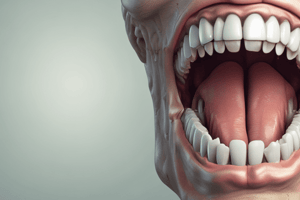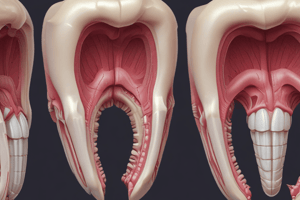Podcast
Questions and Answers
What is the medical term that describes the process of tooth formation and eruption?
What is the medical term that describes the process of tooth formation and eruption?
- Odontectomy
- Odonophagy
- Odontoclastogenesis
- Odontogenesis (correct)
What layer separates the ectoderm from the ectomesenchyme in the primitive oral cavity?
What layer separates the ectoderm from the ectomesenchyme in the primitive oral cavity?
- Dermal membrane
- Basement membrane (correct)
- Cell membrane
- Epithelial membrane
During which week of intrauterine life does the continuous band of odontogenic epithelium form?
During which week of intrauterine life does the continuous band of odontogenic epithelium form?
- 6th week (correct)
- 8th week
- 7th week
- 5th week
What is the role of the neural crest cells during tooth development?
What is the role of the neural crest cells during tooth development?
Which component contributes specifically to the development of teeth at the positions of future deciduous teeth?
Which component contributes specifically to the development of teeth at the positions of future deciduous teeth?
What is formed as a result of the division of the primary epithelial band during the 7th week?
What is formed as a result of the division of the primary epithelial band during the 7th week?
What shape do the primary epithelial bands take as they form in the jaws?
What shape do the primary epithelial bands take as they form in the jaws?
What happens to the cells of the vestibular lamina during tooth development?
What happens to the cells of the vestibular lamina during tooth development?
What is the role of the vestibular lamina in tooth development?
What is the role of the vestibular lamina in tooth development?
Which of the following stages does not occur in the tooth development process?
Which of the following stages does not occur in the tooth development process?
What initiates the process of odontogenesis?
What initiates the process of odontogenesis?
Which genes are identified as earliest mesenchymal markers for tooth formation?
Which genes are identified as earliest mesenchymal markers for tooth formation?
What might result from defects in the molecular pathways regulating tooth development?
What might result from defects in the molecular pathways regulating tooth development?
During which stage does tooth development begin to take shape morphologically?
During which stage does tooth development begin to take shape morphologically?
How many genes have been identified as regulators during the initiation of tooth development?
How many genes have been identified as regulators during the initiation of tooth development?
What does the term 'odontogenic pattern' refer to in tooth development?
What does the term 'odontogenic pattern' refer to in tooth development?
What condition results from the absence of one or more teeth due to lack of initiation?
What condition results from the absence of one or more teeth due to lack of initiation?
What is the role of Fgf-8 in tooth development?
What is the role of Fgf-8 in tooth development?
Which gene is known to colocalize with the sites where tooth germs appear?
Which gene is known to colocalize with the sites where tooth germs appear?
What condition is referred to when more than six teeth are congenitally missing?
What condition is referred to when more than six teeth are congenitally missing?
Which type of teeth are classified as mesiodens when located in the midline of the anterior maxilla?
Which type of teeth are classified as mesiodens when located in the midline of the anterior maxilla?
What is the outcome of abnormal tooth initiation due to hyperactivity of the dental lamina?
What is the outcome of abnormal tooth initiation due to hyperactivity of the dental lamina?
Which of the following describes the complete positional interchange of two adjacent teeth?
Which of the following describes the complete positional interchange of two adjacent teeth?
Which growth factor is known to repress Pax-9 expression in tooth development?
Which growth factor is known to repress Pax-9 expression in tooth development?
Study Notes
Odontogenesis
- Derived from Greek terms; "odon" means tooth and "genesis" means creation.
- Describes the complex process of tooth formation and eruption.
- Involves development into permanent and deciduous (primary) teeth.
Primitive Oral Cavity
- Lined by ectodermal epithelium over a connective tissue called ectomesenchyme.
- Ectomesenchyme originates from ectodermal neural crest cells that migrate to the head and neck.
Dental Arch Formation
- Begins around 37 days of development (6th week of intrauterine life).
- Continuous band of odontogenic epithelium appears in the future upper and lower jaws.
- This band is known as the primary epithelial band.
Primary Epithelial Band
- Divides into two laminae by the 7th week: buccal vestibular lamina and lingual dental lamina.
- Dental lamina is crucial for tooth development, corresponding to the positions of future deciduous teeth.
Stages of Tooth Development
- Tooth development occurs in three distinct stages: bud, cap, and bell.
- Each stage is characterized by specific morphological changes in the tooth germ.
Molecular Regulation of Tooth Formation
- Multiple genes regulate tooth development, involving interactions between dental mesenchyme and epithelium.
- More than 90 genes identified during the initiation phase of tooth development.
Key Genes in Tooth Development
- Homeobox genes control embryonic development; crucial in tooth initiation and positioning.
- Defects could cause conditions like oligodontia (six or more missing teeth).
- Early mesenchymal markers include Lhx-6 and Lhx-7; fibroblast growth factor-8 (Fgf-8) initiates their expression.
- Pax-9 gene crucial for localization of tooth germs, induced by Fgf-8 and repressed by BMP-2 and BMP-4.
- Wnt pathway is pivotal for initiating tooth development.
Clinical Considerations
- Lack of tooth initiation can cause hypodontia (absence of one or more teeth).
- Hyperactivity of the dental lamina leads to hyperdontia (supernumerary teeth).
- Commonly absent teeth include upper lateral incisors, third molars, and lower second premolars.
- Oligodontia refers to the congenital absence of more than six teeth; supernumerary teeth are more frequent in permanent dentition.
Abnormalities of Tooth Form
- Microdontia: smaller than normal teeth.
- Macrodontia: larger than normal teeth.
- Gemination: incomplete division of a single tooth bud.
- Fusion: combination of two adjacent tooth buds.
- Dental transposition: positional interchange of adjacent teeth.
Types of Supernumerary Teeth
- Mesiodens: supernumerary teeth found in the midline of the anterior maxilla.
- Supplemental teeth: extra teeth that resemble normal dentition.
Studying That Suits You
Use AI to generate personalized quizzes and flashcards to suit your learning preferences.
Description
Explore the fascinating process of odontogenesis, the creation of teeth. This quiz covers the formation and eruption of both permanent and deciduous teeth within the dental arch. Enhance your understanding of oral biology and the mechanisms behind tooth development.




